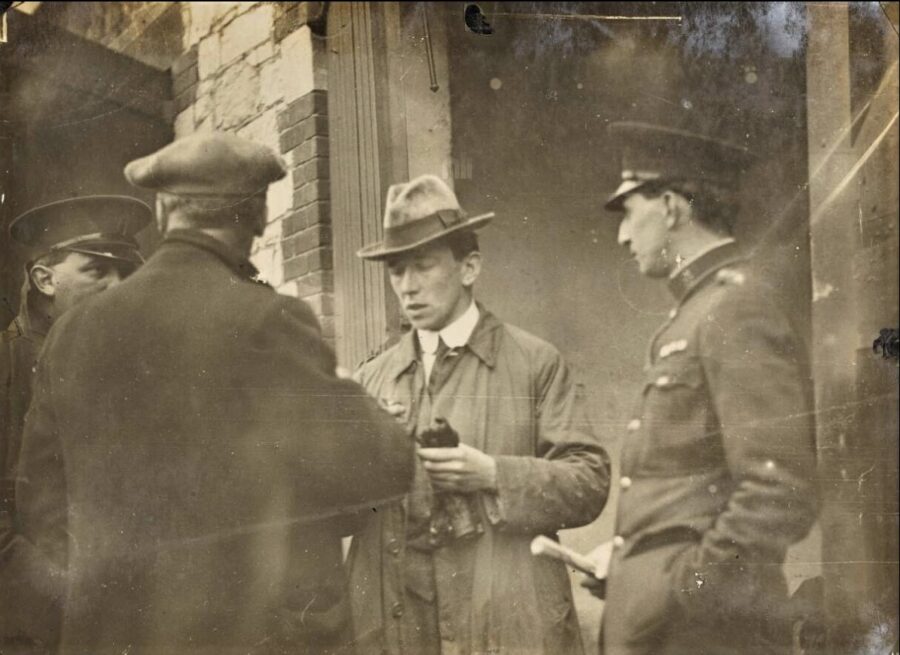
Kieran’s Our City, Our Town Article,
Cork Independent, 21 April 2022
Journeys to a Free State: Disbanding the Royal Irish Constabulary
The establishment of the Irish Constabulary was begun by the Irish Constabulary (Ireland) Act 1836. Previous to this, the Irish police force at the time of the Act of Union of 1800 was still comprised only of small units of sub-constables. Originally, the prime role of the Royal Irish Constabulary was upholding the peace, which involved the suppression of armed rebellion, religious riots or agrarian disturbances. Their position was extended when it took on the functions of the Revenue Police, which involved “inquiries on behalf of departments of state, collected agricultural statistics, enforced the fishery laws and performed a variety of duties under the laws relating to food and drugs, weights and measures, explosives and petroleum”.
In 1867, the Irish Constabulary was renamed the Royal Irish Constabulary (RIC). After 1916 it faced the effect of the violence from the Irish War of Independence.
Following the formation of the Irish Free State in early 1922, on 31 March 1922, the disbandment of the Royal Irish Constabulary began in southern Ireland. They were to be replaced by the creation of the Irish Free State’s Civic Guard. Approximately 7,000 RIC men, excluding officers, awaited disbandment in Ireland with many waiting to evacuate barracks in various parts of the country. Of these, between 4,000 and 5,000 were focussed in the Dublin and Kildare area.
Britain’s National Archives in Kew, London records that pensions were paid by the Paymaster General in London, and the service records of members of the force passed to the Home Office which were subsequently transferred to The National Archives. An annual sum of £1,500,000 was put aside for their pensions. This sum was guaranteed by the British parliament and, under the Anglo-Irish Treaty, all or part of it was to be provided by the Irish government.
In Cork, in early April 1922, there was ongoing fallout from the murder of a former member of the RIC who was shot dead on a crowded Cork City street on 25 March. Retired William Gloster, a former sergeant, returning to his home at Elizabeth Fort was passing through the southern end of South Main Street at 1.30 pm when a group of young men shot him at least six times.
On 12 April 1922, the handing over of the city’s RIC Barracks began. There was considerable activity in the vicinity of the Bridewell and Tuckey Street when both those barracks, as well as the annexe on the latter, on the Grand Parade, were handed over by the RIC to an officer of the IRA from Dublin. At 11am, District Inspector Riordan, Union Quay attended at the Bridewell, where he was met an IRA officer from Dublin, and some local IRA officers. There, with the assistance of Head Constable Nestor and Sergeant McCoy, the station sergeant, an inventory of the property being left was made. By 11am the RIC walked out, leaving an IRA guard in charge.
The party then proceeded to Tuckey Street, where District Inspector Riordan again handed over the barracks to the IRA officer. Then the annexe on the outer side of Tuckey Street, and overlooking the Grand Parade was visited, and a like process was gone through. Large crowds remained outside both barracks during the process of evacuation, but there were no disturbances. The police from both barracks then went to Union Quay.
The other three barracks were evacuated the following day on 13 April – the barracks an Empress Place on Summerhill North, Elizabeth Fort and Union Quay, with its annexe at Moore’s Hotel at Morrison’s Island. These were handed over to the Lord Mayor of Cork, Cllr Donal Óg O’Callaghan.
Union Quay took more than two hours to complete the checking of the inventory before it was officially handed over by Captain Moran to the Lord Mayor. It was a large spacious building of modern brick, built and capable of affording accommodation to upwards of 150 men. Before they were completely departed at Union Quay. Constable Lowry, the men’s representative, approached the pressmen present, and said he had desired on behalf of the old city force to express their gratitude to the people of Cork. Some of them has been in the force for over 30 years.
From early morning, the RIC were busily engaged in removing luggage to the City’s Custom House Quay, where the steamer, SS Lady Wicklow, was berthed. The vessel was specially chartered for the conveyance of RIC members to Dublin. The steamer hosted 20 officers, 400 police, with all their luggage and equipment on board.
At the quayside, City Councillor and Home Rule supporter Sir John Scott was present and noted that he had been present when the barracks were handed over to the Lord Mayor for Cork Corporation. He noted that he had experienced a feeling of pleasure and also of regret – pleasure of meeting once more members of the RIC, and regret when he came to think that they were leaving the city. Continuing he paid a fine tribute to the officers and members of the force, and wished then “every good luck, long life and prosperity in the future”. At the close of Sir John Scott’s address, a policeman who said he was of the oldest members of the force, expressed thanks, and called for three cheers for Scott.
In mid-May 1922 disbandment commenced at Cork’s Victoria Barracks.
Caption:
1147a. Lord Mayor of Cork, Cllr Donal Óg O’Callaghan receiving the keys of the Union Quay barracks, Cork, 13 April 1922 (W D Hogan Collection, National Library of Ireland).